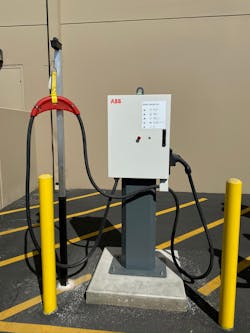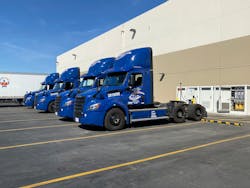Fleet shares experience with current electric truck testing
Supply chain solutions provider NFI Industries conducts business in several facets of the supply chain industry, from warehousing to brokerage and logistics. The transportation division of the company also operates 4,500 commercial trucks throughout North America, and 2,600 of those trucks are owned assets.
The fleet is currently testing commercial electric trucks (CEVs) in Southern California for port drayage applications.
NFI currently operates 39 full battery-electric commercial vehicles, including 27 Kalmar Ottawa T2E terminal tractors, 10 Freightliner eCascadia Class 8 CEVs, and two Volvo VNR Electric Class 8 CEVs.
The fleet first started running the eCascadia trucks in August 2019; and received the VNR Electric trucks in the first quarter of 2021. NFI began operating a few T2E yard tractors in March of 2020, adding several per month throughout the rest of 2020.
NFI acquired various CEVs through government funding as well as OEM leasing programs for respective truck manufacturers.
The yard tractors were acquired through the California Air Resource Board Hybrid and Zero-Emission Truck and Bus Voucher Incentive Project (HVIP).
“We are leasing our current Volvo VNR Electrics through Volvo Financial Services. These trucks were manufactured with the help of funding from CARB and the South Coast AQMD (air quality management district) through the Volvo LIGHTS program,” noted James O’Leary, vice president of assets for NFI Industries.
The yard tractors have been used to move trailers throughout the yard for very short distances, while the Class 8 tractors have been utilized for port drayage applications, between the Ports of Los Angeles and Long Beach and Chino, California.
O’Leary said the reason for testing has been driven by a core value and strategy of the company: sustainability. “Now more than ever our customers want to collaborate with fleets that share their sustainable vision, and we want to be in a position to help them achieve their goals. We also believe that our port drayage application is the perfect use case for BEVs,” he said.
As part of the fleet’s preparedness, O’Leary noted drivers received a half day of training as an introduction to the CEVs to learn about features such as how to take advantage of and best utilize regenerative braking to increase battery range.
“The trucks are well-received by all who interact with them,” O’Leary said. “Drivers love the quietness, power, and quality of life increase that comes with these trucks.”
Infrastructure considerations
NFI worked with local utilities providers to install on-site, or “behind-the-fence” charging stations. Currently, the fleet has three different charging station types to accommodate recharging of the three different vehicle types.NFI has five 150 kW power cabinets—each equipped with one charging dispenser designed to the CCS1 charging standard—to recharge the 10 eCascadia trucks. The fleet also has two power cabinets, with each cabinet including two charging dispensers designed to the CCS2 charging standard, allowing the ability to have four trucks hooked up at one time. “When truck A is finished charging, it will then go and start charging truck B. But it can only charge one truck at a time either way,” O’Leary said.
One challenge currently is that the CCS1 and the CCS2 standards are different plug designs. “The Volvo Trucks can't plug in the Daimler chargers and the Daimler trucks can't plug in the Volvo chargers. That is not an ideal scenario, but one that we're willing to work through in this pilot phase,” said O’Leary.
Additionally, separate charging stations are set up for the T2E yard trucks.
O’Leary confirmed the process to assess infrastructure involved site walkthroughs with the truck manufacturers, the utilities provider and the engineering firm tasked with the installation of charging stations. “The Volvo LIGHTS planning was more than 12 months, the Daimler planning was nine months from those first walkthroughs to delivered product with lots of different project stakeholders involved,” he explained, regarding assessment before charging station installation.
A partnership with both the truck manufacturers as well as utilities providers is critical to the success of CEV adoption within a fleet, noted O’Leary. He advised one takeaway he would share learning from this initial experience is weighing infrastructure charging needs just as much as the spec’ing of the vehicles themselves.
“The same amount of rigor that you're going through with talking to the OEs also needs to be done when you're talking to those EVSE (electric vehicle supply equipment) manufacturers,” suggested O’Leary. This proved a challenge because he advised “you don’t know what you don’t know” when it comes to knowing which questions are pertinent to ask during the assessment and installation process.
Of the lessons learned by NFI, O’Leary advised asking questions to confirm expected uptime of vehicles from a charging standpoint, including things like location of chargers, methods for charging and length of charge time. Additionally, be sure to incorporate service-level agreements (SLAs) into contracts.
“You're still worried about the tractor uptime, but you need that charger available to charge,” O’Leary said. “There's no worse thing than for a driver to show up and not have his truck charged for the day of work.”
Future plans
While still preliminary, O’Leary noted the fleet has discussed expanding adoption of CEVs to the entire 65-truck fleet for the California drayage operation. Additionally, NFI is looking at the possibility of expanding to other port drayage applications, including Texas and South Carolina. O’Leary advised the testing of CEVs has been prioritized by application and incentive.
“Right now, there are other applications—shuttles and small dedicated fleets within 150-mile routes and those types of things that are also prime—but there are things, and those are application driven, incentive driven. You know, those are the two things that we're looking at right now to say, OK, where are we doing this next? What's the next project? Where are we doing this? It's application driven, incentive driven at this particular point.”
The Class 8 CEVs currently run by NFI are pre-production models. The fleet plans to return the pre-production models in exchange for full production models, in hopes there will be a seamless transition so the on-site infrastructure does not go unused.Currently, NFI works with respective truck OEMs and dealerships to plan service and maintenance for the CEVs. A primary reason for dealership service has been because NFI is currently running pre-production vehicles which have proprietary parts and information. “Currently, a lot of those major electrical components, and some of the things that the technicians might not be used to, are being handled at the dealers,” said O’Leary of managing service schedules for the pre-production CEVs.
In preparation for expansion of CEV usage for NFI, O’Leary anticipates planning additional training for technicians to begin managing on-site service.
“Our technicians were given a ‘Level 1’ training, but to be able to be certified completely in EVs you have to be Level 3 certified, which means you need special tooling, special PPE, special designated areas in the shop,” O’Leary explained. “And that goes from one- to two-day training to multiple days or a week's worth of training to get certified.” He confirmed that as NFI adds more CEVs to its fleet, the organization has plans to have technicians obtain Level 3 training for servicing CEVs.
As it relates to charging infrastructure, O’Leary anticipates more standardization to allow for optimizing charging units. “I know the industry is also working on coming up with a new standard for high efficiency fast-charging, that should be coming up in the next few years,” he said.
About the Author
Erica Schueller
Editorial Director | Commercial Vehicle Group
Erica Schueller is a former editorial director of the Endeavor Commercial Vehicle Group.



